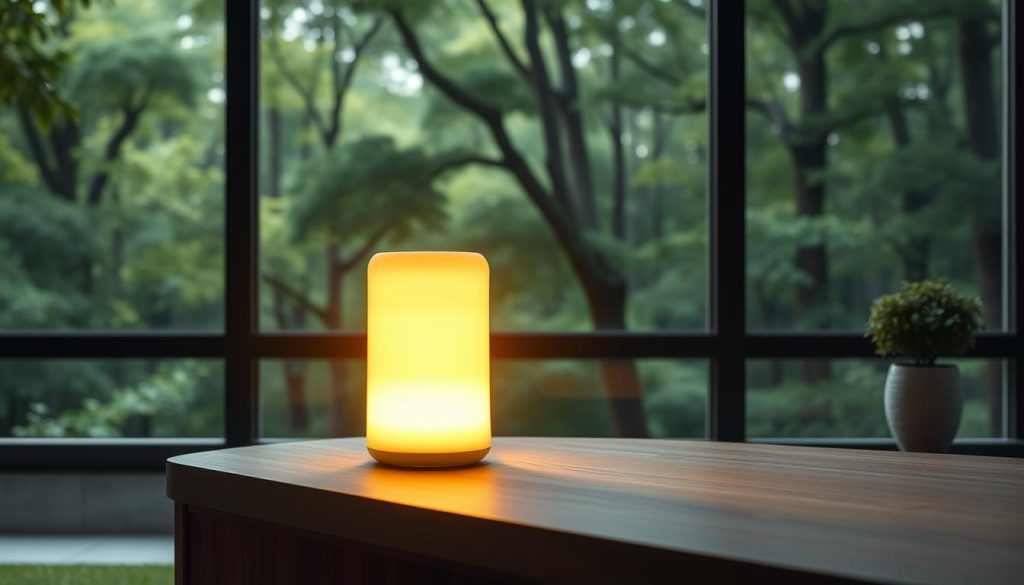In today’s fast-paced world, finding peace can seem hard. Forest bathing offers a way to find calm. It combines nature’s peace with the health benefits of negative ions. Imagine walking in a forest, breathing in fresh air—it’s like getting a natural boost for your body and mind.
Forest bathing, or shinrin-yoku, is more than a simple walk. It’s about fully experiencing nature to reduce stress and improve health. It’s linked to negative ions, which are found in nature and help our health. This practice is showing many benefits that doctors are starting to understand.
In this article, we’ll look into forest bathing’s history and how negative ions work. We’ll see how they together affect our health. We’ll also share ways to add this natural wellness practice to your daily life.
Introduction to Forest Bathing
Forest bathing, or shinrin-yoku, is a Japanese practice that means ‘taking in the forest atmosphere’ or ‘forest bathing’. It’s about immersing yourself in nature to feel better. This method is known for its calm and health benefits.
What is Forest Bathing?
Forest bathing, also called forest therapy, is about spending time in nature. It’s about slow, mindful walks in the forest, letting your senses take it all in. It’s more than just a walk; it’s a way to deeply connect with nature.
History and Origins of Shinrin-Yoku
Shinrin-yoku started in Japan in the 1980s to fight stress and city life. The Japanese Ministry of Agriculture, Forestry, and Fisheries brought it up to help people’s health. Now, it’s popular worldwide, including in Western countries.
The Science Behind Forest Therapy
Science backs up forest therapy as a way to boost health. Studies show it lowers stress, blood pressure, and improves mood. Shinrin-yoku’s health benefits are real, thanks to science.
In short, forest bathing mixes old wisdom with new science. It helps find balance between mind, body, and nature. It’s a peaceful escape from today’s fast life.
Understanding Negative Ions
Negative ions are tiny particles with an extra electron. They are found in nature and can help our health. Scientists study them because of their many benefits.

Definition and Nature of Negative Ions
Negative ions have an extra electron, making them charged. This happens in places like forests, waterfalls, and oceans. They can clean the air by removing pollutants.
These ions are also good for our mood and energy. They can help with anxiety and depression too.
Sources of Negative Ions in Nature
Nature is full of places that make negative ions. Forests are a big source because of all the plants and trees.
Waterfalls, beaches, and mountains also have lots of negative ions. The movement of air and water helps create these healthy particles.
Here’s a table showing where you can find negative ions in nature:
| Natural Source | Typical Negative Ion Levels (ions/cm³) |
|---|---|
| Forests | 1,000 – 2,000 |
| Waterfalls | 2,000 – 5,000 |
| Mountains | 1,500 – 3,000 |
| Beaches | 1,000 – 1,500 |
The Natural Benefits of Forest Bathing and Negative Ions
Forest bathing and negative ions offer great benefits for both mind and body. Being in nature helps improve health in many ways. The mix of forests and negative ions brings many advantages.
Stress Relief and Relaxation
Forest areas help reduce stress. Negative ions lower cortisol levels, calming the mind and body. Studies show that fresh, ion-rich air cleanses the lungs and promotes calm breathing.
This leads to relaxation and less daily stress. It helps improve mental health.
Enhanced Mood and Mental Clarity
Forest bathing boosts mood and mental clarity. Negative ions increase serotonin, which stabilizes mood. This makes us more alert and focused.
The calm of forests also improves mental clarity. It makes tasks and thoughts easier to handle.
Physical Health Improvements
Forest bathing and negative ions also improve physical health. They boost the immune system and reduce inflammation. The air in forests is clean, helping the lungs work better.
Regular visits can lower blood pressure. This is good for the heart.
Forest bathing is a complete way to improve health. It combines mental calm with physical benefits through negative ions.
How to Practice Forest Bathing
Forest bathing, or Shinrin-Yoku, is a way to connect with nature. It helps us feel well and calm. To get the most out of it, follow some key steps.
Choosing the Right Location
Finding the right spot for forest bathing is important. Look for places full of life and away from city sounds. National parks and nature reserves are great choices. Make sure they have paths for a peaceful walk.
Preparing for Your Forest Walk
Getting ready is crucial for a good forest bathing session. Wear comfy clothes and shoes that can handle trails. Bring water, snacks, and a first aid kit. A nature app can help guide you and teach you about the plants and animals.
Tips for Maximizing the Experience
To really connect with nature, try these tips:
- Disconnect: Turn off your phone to stay focused.
- Sensory Engagement: Notice the sights, sounds, smells, and feels around you.
- Mindful Breathing: Use deep breaths to match the forest’s pace.
- Reflection: Stop and write down your thoughts or feelings in a journal.

By following these tips and using a nature app, your walk can become a deep, meaningful experience. Nature’s calm and healing are waiting for you.
Scientific Research on Forest Therapy
Our understanding of natural healing is growing. Many studies have looked into the benefits of forest therapy. They show how spending time in forests can improve our health.
Key Studies and Findings
Research from the Nippon Medical School in Tokyo shows forest therapy boosts our immune system. It increases the activity of natural killer cells, which fight infections and cancer. Also, studies in Environmental Health and Preventive Medicine found it lowers stress by reducing cortisol levels.
Forest environments have calming effects, many studies confirm. For example, research by Qing Li at Nippon Medical School found that tree compounds improve mood and reduce anxiety.
Research in the International Journal of Environmental Research and Public Health also found benefits. It shows forest therapy can lower heart rate and blood pressure. These findings support the idea of using forest therapy for health.
| Study | Institution | Findings |
|---|---|---|
| Immune Function Improvement | Nippon Medical School | Increased natural killer cell activity |
| Stress Reduction | Environmental Health and Preventive Medicine | Lowered cortisol levels |
| Mood Enhancement | Nippon Medical School | Improved mood and reduced anxiety |
| Cardiovascular Benefits | International Journal of Environmental Research and Public Health | Reduced heart rate and blood pressure |
Everyday Ways to Incorporate Negative Ions
Adding negative ions to our daily lives can boost air quality and well-being. Forest bathing is a natural way to enjoy negative ions. But, we can also use negative ion generators at home and in the office. Plus, outdoor activities can help too.

Home and Office Tips
Using negative ion generators is a smart move for cleaner air indoors. These devices release ions that trap dust and allergens, making the air safer to breathe. Also, plants like spider plants and peace lilies can help by releasing negative ions naturally.
Outdoor Activities and Practices
Outdoor activities can expose you to more negative ions. Hiking, walking near waterfalls, or being by the sea are great ways to get more. These places have lots of negative ions in the air.
In short, using negative ion generators and spending time in nature are great ways to keep air clean and healthy. Whether you’re inside or outside, there are many ways to enjoy the benefits of negative ions.
Personal Stories and Anecdotes
Forest therapy has changed many lives, offering deep healing and new views. One person found peace after struggling with burnout. They walked through greenery, breathed fresh air, and found calm.
A veteran with PTSD found peace in forests. The calm helped them escape daily stress. Their story shows how forests can heal and clear the mind.
Families and children also benefit from forest therapy. Their stories show how nature brings joy and connection. Each story proves the power of nature in healing and growth.
Comparing Forest Bathing with Other Nature Therapies
Looking at different nature therapies shows how they help us in various ways. Each one, like forest bathing, hiking, or beach therapy, has its own special benefits. They all help our mental and physical health in different ways.
Forest Bathing vs. Hiking
Forest bathing, or Shinrin-Yoku, focuses on being mindful and fully present in nature. It’s about soaking in the forest’s healing energy. Unlike hiking, which is about moving and exploring, forest bathing is slower. It lets you really connect with nature.
The forests have lots of negative ions. These ions are thought to lower stress and make us feel happier.
Forest Therapy vs. Beach Therapy
Forest therapy takes you into a peaceful world of trees and plants. It’s quiet and secluded. On the other hand, beach therapy offers the calming sounds of waves and wide ocean views. It’s a different kind of therapy.
Potential Risks and Precautions
Forest bathing is great for your health, but it’s important to be aware of risks. Taking the right precautions can make your experience better. It’s all about staying safe and protecting the forest.
Aware of Environmental Factors
When you’re in the forest, watch out for slippery paths and sudden rain. Wearing the right shoes can help a lot. Also, knowing the weather beforehand is key.
Being mindful of the environment is crucial. This way, you can enjoy the forest without harming it.
Understanding Personal Health Conditions
Before you start forest bathing, think about your health. If you have breathing problems or allergies, talk to a doctor first. This makes sure you have a safe and enjoyable time.
The Future of Forest Bathing and Negative Ions
The future of forest bathing and negative ion research is exciting. It combines ancient practices with modern technology. This blend will deepen our connection with nature in new ways.
Researchers are eager to make nature therapy a common wellness practice. They believe it can greatly improve our mental and physical health. This is based on growing evidence.
Technology could change how we experience forest bathing. Wearable devices might track our health during these sessions. They could monitor heart rate and stress levels in real time.
This tech integration will make forest therapy more scientific and effective. It will also make our experiences more personal. Apps and virtual reality could also play a big role in bringing forest bathing to more people.
The world of nature therapy is set to evolve further. It will mix old wisdom with new science. This could lead to indoor spaces that feel like forests, offering calm and renewal.
Studies will also explore how different nature spots affect our health. This could lead to nature experiences tailored to each person’s needs. As more people look for holistic wellness, the future of forest bathing and negative ions is bright.

